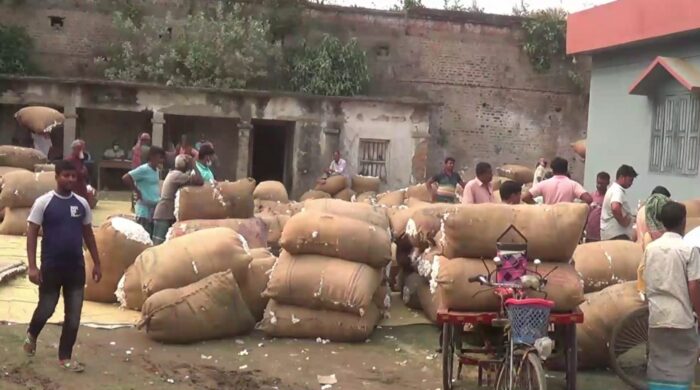
Cotton farming has seen a revival in five south western districts and farmers are seeing to gain extra buck of profit from this year as the government increased price of this textile fibre by more than Tk. 1,000 to Tk.1200 per maund.
The five districts are Jashore, Jhenaidah, Kushtia, Meherpur and Chuadanga. Farmers in these districts had continued to face losses cultivating cotton mainly for prices.
Officials of Bangladesh Cotton Development Board (CDB) said, this farming surge was driven by the availability of quality seeds, reduced labour exigencies and the opportunity of cultivating other crops alongside the cotton. Additionally, the government provided various incentives, including subsidized fertilizers, seeds and loan assistance to the farmers.
Besides, the farmers cultivated companion crops alongside the cotton and also earnings further benefit from the same land.
According to CDB sources, the target for cotton cultivation in these five districts was set at 16,900 hectares this season, where cultivation exceeded the expectations, reaching 17,018 hectares. Favourable weather has resulted in high yields where farmers produce 15 to 18 maunds of cotton per bigha.
This season, cotton was cultivated on 2,375 hectares in Kushtia, 2,100 hectares in Chuadanga, 4,335 hectares in Meherpur, 3,400 hectares in Jashore and 4,408 hectares in Jhenaidah district.
The farming of the fibre typically begins in mid-July and continues until mid-September. Harvesting starts in January and lasts until April.
This year, farmers have been supplied with high-yield cotton seed varieties such as White Gold-1, White Gold-2, Rupali-1 (Hybrid), DM-4 (Indigenous), Shubhra-3, and Ispahani Lal Teer.
The CDB officials stated that loamy, alluvial and elevated land are ideal for cotton cultivation, making these districts in the Khulna Division major commercial cotton-growing zones after the hilly regions.
Farmers are now adopting seedling methods and high-yield hybrid varieties, driving up demand due to the superior quality of the cotton produced.
Mizanur Rahman, the Chief Cotton Officer of the Jashore Regional Cotton Development Office, mentioned that various initiatives are being implemented to support farmers in this endeavour like training, organising field days and providing new seed varieties each season.
“To facilitate seed cotton collection, four seed cotton harvesting machines have been distributed for trial use across four zones this season,” the official said.
With this, the government ensured soft loans to farmers for cultivating cotton which they typically repay after selling their cotton harvest, he added.
According to him, cotton farming is more profitable than most other crops. Typically, the cost of cotton farming is around Tk. 10,000 to Tk. 12,000 per bigha.
Farmers’ Success Stories/
Government, after the end of the season last year raised cotton prices to protect the farmers from continuous losses.
They said, cotton prices increased by Tk 1,200 per maund compared to previous years, now ranging from Tk 3,000 to Tk 4,000 per maund, bringing much-needed relief and optimism to farmers.
They said that as the cotton is a six-month crop, farmers can easily cultivate companion crops like red spinach, radish, and mung beans between the cotton rows. This allows them to maximize land use and generate additional income.
Shahinuzzaman, a cotton farmer from Betbari village in Gangni Upazila of Meherpur, shared that last year he grew cotton on three bighas of land and made a good profit after covering expenses for production costs. Encouraged by this success, he expanded his cultivation to 9 bighas this year, anticipating a net profit of Tk 60,000 per bigha after deducting production costs of Tk.25,000 per bigha.
Nawab Ali, a farmer from Jhenidah, noted that in previous years, cotton farming barely covered expenses. However, due to last year’s price hike, he made some profit, prompting him to expand cultivation to five bighas this year.
S.M Sweet Hossain, a cotton farmer from Begumpur village in Chuadanga Sadar Upazila, highlighted that for several years, the government had set the price of cotton at Tk. 2,400 per maund. However, this year, the price has been raised from Tk.1, 200 to Tk. 3,600 per maund, allowing farmers to earn better profits. If prices remain high, more farmers will be encouraged to cultivate cotton.
This farmer shared that he received fertilizers, seeds, and loan support from the local Cotton Development Board.
Yearul Islam, a cotton farmer from Dharmadah village in Daulatpur Upazila, Kushtia, pointed out that due to rising production costs, profits are lower at current market prices. Farmers have urged authorities to set cotton prices in alignment with international rates.
Ghulam Farhad, owner of Al Madina Industries Ltd. in Kushtia, noted that Kushtia-region cotton is highly valued due to its fiber quality. Local mill owners and traders set purchase prices based on international market trends.
Debashish Sen, the Executive Officer of the Chuadanga Cotton Development Board, stated that depending on quality, farmers are selling cotton at rates reaching up to Tk. 4,000 per maund.
Sheikh Al Mamun, Chief Cotton Development Officer of Kushtia, reassured that despite government-set prices, farmers can earn additional profits based on cotton quality. He emphasized that there is no risk of losses.
According to CDB sources, Bangladesh’s annual cotton demand is 7.3 to 7.4 million bales (1 bale = 140 kg). However, domestic production is only 170,000 to 180,000 bales. The shortfall is met through imports from neighboring India and other countries, costing approximately BDT 300 billion per year.